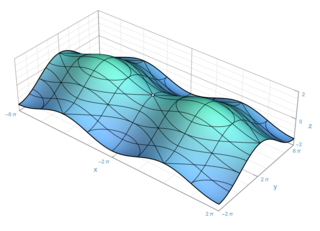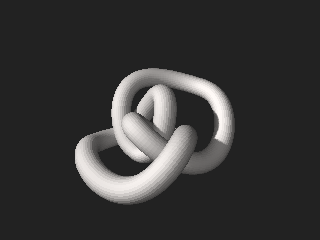Related Research Articles

In topology and related branches of mathematics, a connected space is a topological space that cannot be represented as the union of two or more disjoint non-empty open subsets. Connectedness is one of the principal topological properties that are used to distinguish topological spaces.

In complex analysis, the Riemann mapping theorem states that if U is a non-empty simply connected open subset of the complex number plane C which is not all of C, then there exists a biholomorphic mapping f from U onto the open unit disk

In the part of mathematics referred to as topology, a surface is a two-dimensional manifold. Some surfaces arise as the boundaries of three-dimensional solids; for example, the sphere is the boundary of the solid ball. Other surfaces arise as graphs of functions of two variables; see the figure at right. However, surfaces can also be defined abstractly, without reference to any ambient space. For example, the Klein bottle is a surface that cannot be embedded in three-dimensional Euclidean space.

In mathematics, topology concerns with the properties of a geometric object that are preserved under continuous deformations, such as stretching, twisting, crumpling, and bending; that is, without closing holes, opening holes, tearing, gluing, or passing through itself.

In mathematics, the winding number or winding index of a closed curve in the plane around a given point is an integer representing the total number of times that curve travels counterclockwise around the point, i.e., the curve's number of turns. The winding number depends on the orientation of the curve, and it is negative if the curve travels around the point clockwise.

In mathematics, a curve is an object similar to a line, but that does not have to be straight.

In mathematics, particularly in complex analysis, a Riemann surface is a connected one-dimensional complex manifold. These surfaces were first studied by and are named after Bernhard Riemann. Riemann surfaces can be thought of as deformed versions of the complex plane: locally near every point they look like patches of the complex plane, but the global topology can be quite different. For example, they can look like a sphere or a torus or several sheets glued together.

In mathematics, general topology is the branch of topology that deals with the basic set-theoretic definitions and constructions used in topology. It is the foundation of most other branches of topology, including differential topology, geometric topology, and algebraic topology. Another name for general topology is point-set topology.

In topology, the Jordan curve theorem asserts that every Jordan curve divides the plane into an "interior" region bounded by the curve and an "exterior" region containing all of the nearby and far away exterior points. Every continuous path connecting a point of one region to a point of the other intersects with the curve somewhere. While the theorem seems intuitively obvious, it takes some ingenuity to prove it by elementary means. "Although the JCT is one of the best known topological theorems, there are many, even among professional mathematicians, who have never read a proof of it.". More transparent proofs rely on the mathematical machinery of algebraic topology, and these lead to generalizations to higher-dimensional spaces.
In mathematics, the uniformization theorem says that every simply connected Riemann surface is conformally equivalent to one of three Riemann surfaces: the open unit disk, the complex plane, or the Riemann sphere. The theorem is a generalization of the Riemann mapping theorem from simply connected open subsets of the plane to arbitrary simply connected Riemann surfaces.

In the branch of mathematics known as topology, the topologist's sine curve or Warsaw sine curve is a topological space with several interesting properties that make it an important textbook example.
In mathematical analysis, a space-filling curve is a curve whose range contains the entire 2-dimensional unit square. Because Giuseppe Peano (1858–1932) was the first to discover one, space-filling curves in the 2-dimensional plane are sometimes called Peano curves, but that phrase also refers to the Peano curve, the specific example of a space-filling curve found by Peano.
In topology, a topological space is called simply connected if it is path-connected and every path between two points can be continuously transformed into any other such path while preserving the two endpoints in question. The fundamental group of a topological space is an indicator of the failure for the space to be simply connected: a path-connected topological space is simply connected if and only if its fundamental group is trivial.
In mathematics, Carathéodory's theorem is a theorem in complex analysis, named after Constantin Carathéodory, which extends the Riemann mapping theorem. The theorem, first proved in 1913, states that the conformal mapping sending the unit disk to the region in the complex plane bounded by a Jordan curve extends continuously to a homeomorphism from the unit circle onto the Jordan curve. The result is one of Carathéodory's results on prime ends and the boundary behaviour of univalent holomorphic functions.

In topology and other branches of mathematics, a topological space X is locally connected if every point admits a neighbourhood basis consisting entirely of open, connected sets.
In mathematics, the Schoenflies problem or Schoenflies theorem, of geometric topology is a sharpening of the Jordan curve theorem by Arthur Schoenflies. For Jordan curves in the plane it is often referred to as the Jordan–Schoenflies theorem.
In mathematics, a quasicircle is a Jordan curve in the complex plane that is the image of a circle under a quasiconformal mapping of the plane onto itself. Originally introduced independently by Pfluger (1961) and Tienari (1962), in the older literature they were referred to as quasiconformal curves, a terminology which also applied to arcs. In complex analysis and geometric function theory, quasicircles play a fundamental role in the description of the universal Teichmüller space, through quasisymmetric homeomorphisms of the circle. Quasicircles also play an important role in complex dynamical systems.

In topology, the Denjoy–Riesz theorem states that every compact set of totally disconnected points in the Euclidean plane can be covered by a continuous image of the unit interval, without self-intersections.
In mathematics, a planar Riemann surface is a Riemann surface sharing the topological properties of a connected open subset of the Riemann sphere. They are characterized by the topological property that the complement of every closed Jordan curve in the Riemann surface has two connected components. An equivalent characterization is the differential geometric property that every closed differential 1-form of compact support is exact. Every simply connected Riemann surface is planar. The class of planar Riemann surfaces was studied by Koebe who proved in 1910, as a generalization of the uniformization theorem, that every such surface is conformally equivalent to either the Riemann sphere or the complex plane with slits parallel to the real axis removed.
References
- Bing, R. H. (1983), The Geometric Topology of 3-Manifolds, Colloquium Publications, vol. 40, American Mathematical Society, ISBN 0-8218-1040-5
- Pommerenke, C. (1975), Univalent functions, with a chapter on quadratic differentials by Gerd Jensen, Studia Mathematica/Mathematische Lehrbücher, vol. 15, Vandenhoeck & Ruprecht
- Pommerenke, C. (1992), Boundary behaviour of conformal maps, Grundlehren der Mathematischen Wissenschaften, vol. 299, Springer, ISBN 3540547517